How to pick, store, stew and serve up some surprises
Each spring, gardeners plant tomato seedlings or seeds with a sense of hope and expectation. Come late summer and early fall, though, when the fruit weighs heavy on the vine, that hope might turn to anxiety. How do we race against the frost to reap all that we’ve sown? Then, once the reaping is done, what do we do with it all?
But for Perry Michetti (Cooking ’90), Culinary Arts and professional food studies department head, this is always a happy time of year. He grows about 15 plants and usually four varieties each year, including the meaty Super Fantastic, the early producing Manitoba, a cherry such as the heirloom Tiny Tim, and the Italian roma variety, San Marzano – “the king of sauce,” says Michetti, reverently.
“[Tomatoes are] something we have been growing and eating and cooking my whole life with my family,” he says. “But also, as a professional chef, tomatoes are a pretty important item in the kitchen. They serve so many purposes.”
They’re essential to pasta and pizza sauce, of course, but tomatoes are also foundational to myriad aspects of food prep, says Michetti. They’re great for marinades, for example, because the acidity helps to break down collagen in meats in stews and vegetable fibres in stocks. And then there’s always burgers or sandwiches that are incomplete without a nice slice of, say, fresh Super Fantastic.
Here, Michetti explains how to realize all of these benefits and more, and enjoy the fruits of your labours without the task feeling terribly laborious.
Protect your tomatoes

Watch the forecast. If frost is imminent, cover tomatoes with old blankets, sheets or burlap, says Michetti.
“Never use plastic tarps. It just freezes right through.” Uncover during the day so plants can soak up the last of the season’s sunshine.
Don’t put off the harvest
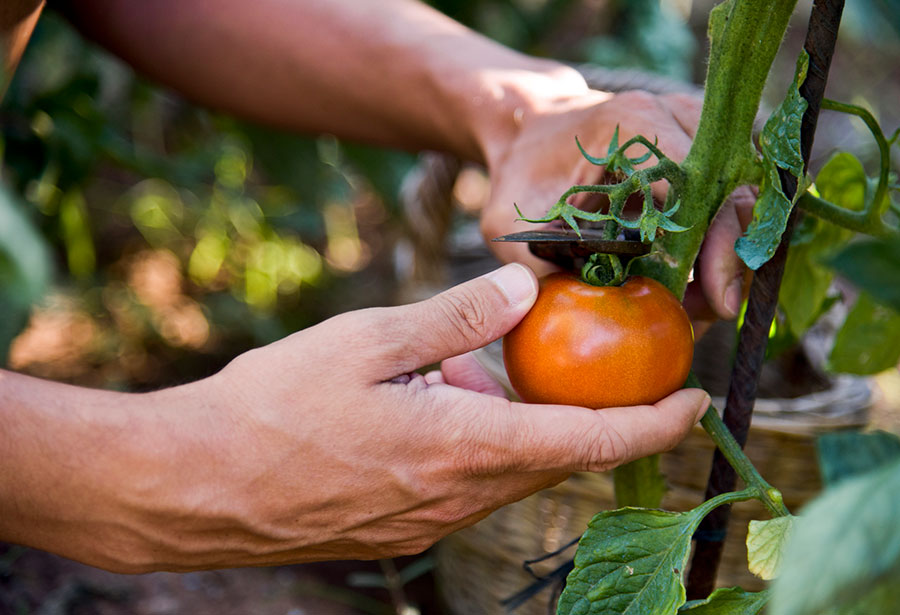
“So often it happens that when the bad weather comes, it comes quickly, and often there's rain or sleet that day,” says Michetti, speaking from experience.
“So now you're dealing with wet tomatoes, which is not fun because you're laying all those blankets out on your living room floor and putting all your tomatoes on them for a couple of days to dry.”
Once the daytime highs aren’t better than about 15 C, tomatoes aren’t growing much more anyway. They’ll ripen just fine indoors, Michetti says.
Harvest dry, and indiscriminately
Hold off on watering and wait for a nice, sunny day to get picking, says Michetti. Consider using a tough pair of scissors or garden shears to keep a bit of the stem attached. “If that stem is pulled out, the tomato will tend to lose a little moisture through there.”
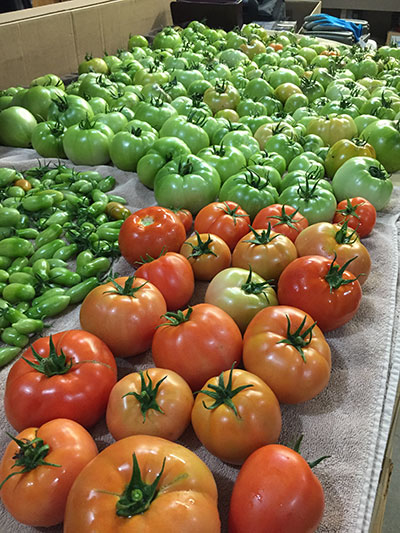 Don’t be picky about weird shapes or minor blemishes, Michetti adds. Grab it all. Keep in mind that what you see in a grocery store is the best of the bunch, he says.
Don’t be picky about weird shapes or minor blemishes, Michetti adds. Grab it all. Keep in mind that what you see in a grocery store is the best of the bunch, he says.
“The truth is, that's only about 30% of tomato crops. Seventy percent are what we classify as ‘ugly fruit.’”
The same goes for the home harvest. Many fruits will be misshapen or marked or both. Instead of chucking them, just clean them up.
“They're perfectly fine to use and cook and eat.”
Ripen in the open
Cardboard boxes, stored at room temperature, are great for unripened tomatoes, says Michetti. Plastic bags are not, as they trap moisture that can promote rot. Leaving the boxes open will keep ripening to a reasonable pace.
“If you picked your crop and it ranges from super ripe to super green, you may have tomatoes ripening right into December, which is good,” says Michetti.
Stew them to store them
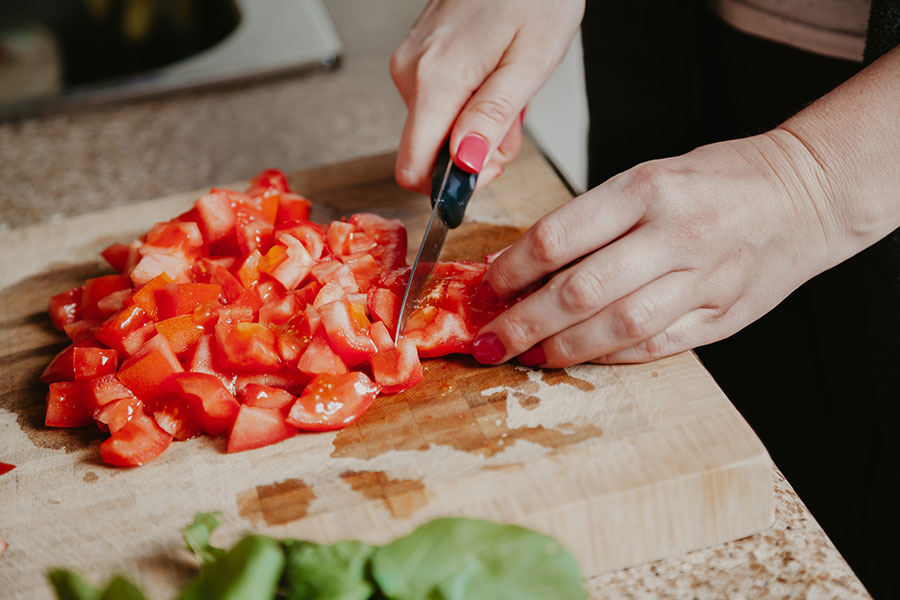
Once your tomatoes are ripe, process them or lose them (if you're not going to eat them right away, which is likely impossible – a single plant can produce eight to 10 pounds of fruit). Thanks to the magic of deep freezers, there’s little reason to go through the hassle of canning, says Michetti. Stew them instead.
Here’s his method:
- Be sure your tomatoes are very ripe. Not mushy, but deep red and a little soft
- Wash thoroughly
- Remove stems and any blemishes (a small tomato stem corer works very well)
- Chop tomatoes into about 1-inch cubes. You will need a serrated or very sharp knife
- Leave skins and seeds intact. They cook down to nothing, so nothing goes to waste
- For every kilogram of tomatoes, add one teaspoon (5 ml) of fine sea salt (sea salt is non-iodized, producing a clean flavour without any metallic or off flavours), ¼ cup (60 ml) of water, one tablespoon (15 ml) of granulated white sugar
- Other additions can also be made to the stewed tomatoes, including fresh basil, fresh oregano, finely minced garlic, a small amount of black pepper
- Simmer on low heat until the tomatoes have reduced by at least half (this will take 3-4 hours)
- Remove from heat and let cool. The mixture can be transferred to a stainless bowl and placed in a refrigerator overnight
- Package the stewed tomatoes in whatever size zip-top freezer bag you feel you need. Fill large bags with 4-5 cups of tomatoes, but also fill some small ones for soups, stews and other recipes where less tomato product is required
- Close the bags removing as much air as possible. Make sure you label your bags prior to filling. Include the date and variety of tomato
- Place bags on flat surfaces in your freezer. This will make the bags easier to store afterwards and take up less space
- The frozen stewed tomatoes will easily last up to one year in your freezer without any deterioration of flavour. Using within 6-8 months is preferred
“The stewed tomatoes are perfect for pasta sauces, stew, curry and soups,” says Michetti. “Wherever a stewed or crushed tomato is called for, these will do the job.”
Use them immediately: 2 recipes
Recipe 1: Baby tomato skewers with aged balsamic vinegar
Makes about 24 4”-5” skewers

Soak skewers in water for at least 6 hours before using them (overnight is even better). This softens the wood fibres and helps prevent slivers.
Ingredients
- 48 baby tomatoes (cherry, grape or baby heirloom)
- Baby (mini) bocconcini cheese balls
- 48 fresh basil leaves (larger leaves can be cut into 2-3 pieces)
- Slices of prosciutto ham (cut each slice lengthwise into 3 strips; optional)
- 50 ml extra virgin olive oil
- 50 ml aged balsamic vinegar (preferably from the Italian regions of Modena and Reggio Emilia; look for “Aceto Balsamico Tradizionale di Reggio Emilia DOP” or “Aceto Balsamico Tradizionale di Modena DOP” on the label; 15 years of older is best for this recipe, as it will be syrupy and stick to the ingredients)
- Fresh cracked black pepper
- Coarse sea salt
Method
- Wash the tomatoes, drain and pat dry
- Wash the fresh basil and dry with a paper towel; cut large leaves into 2-3 pieces
- Drain the bocconcini and set aside
- Roll the 1/3 strips of prosciutto ham into shapes like little sleeping bags
- Alternate the ingredients on the skewers: tomato, basil, ham, cheese, basil, etc. ("I have also pitted olives show up on these skewers, and they are a yummy addition," says Michetti.) The length of the skewer will change amounts
- Feel free to adjust ingredients, adding more of one or the other, or removing to suit vegetarians or even vegans – the depth of the dish is in the celebration of the tomato
- Place on serving tray
- 30 minutes before you serve, drizzle the olive oil and balsamic vinegar evenly over all the skewers. Season with Sea salt and fresh cracked black pepper
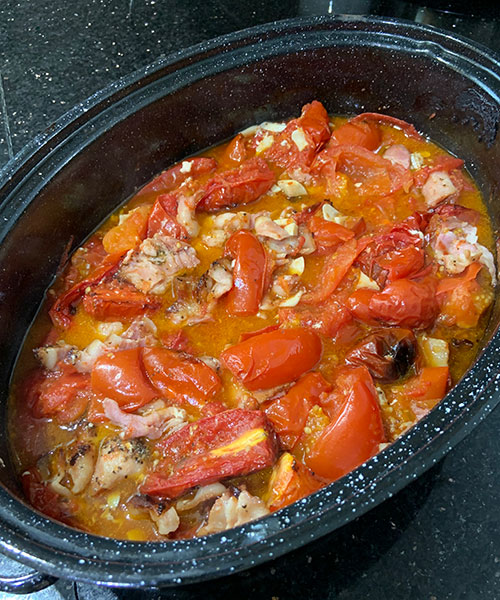 Recipe 2: Roasted tomatoes
Recipe 2: Roasted tomatoes
Serves 4-6
“This is a wonderful, simple recipe that has been made by my family for generations,” says Michetti.
You’ll need perfectly ripened tomatoes that are firm and not mushy. Pair the dish with a crusty baguette and a glass of good red wine to truly appreciate the complexity of the tomato flavour.
Ingredients
- 2.5 kg firm, ripe, fresh tomatoes
- 500 g bacon (not back bacon; substitute with 300 g of pancetta bacon for a more authentic Italian flavour, although the smoked bacon is truly a “Canadian” version)
- 8 large cloves of fresh garlic (preferably from your own garden)
- 1 tsp coarse black pepper (preferably out of a mill)
- 1 tsp fine or coarse sea salt
- 1 tsp dried red chili flakes
- 30 ml extra virgin olive oil
Method
- Preheat your oven to 375 F (190 C)
- Wash the tomatoes
- Remove stems and any blemishes (a small tomato stem corer works very well)
- Cut tomatoes lengthwise into 1- to 2-inch pieces (your preference may be for larger pieces)
- Place the cut tomatoes in a roasting pan
- Peel and roughly chop fresh garlic and add to the tomatoes
- Cut bacon into 1-inch pieces and add to the tomatoes
- Drizzle with the olive oil and sprinkle with salt, pepper and chili flakes
- Gently mix
- Roast uncovered for 60-90 minutes (keep an eye on them, as every oven has its own personality. Don’t overcook – they should be soft but intact, not saucy)
- Consider adding freshly grated parmesan or pecorino romano cheese and a few fresh, torn basil leaves just before serving
Banner image Isuhi/istockphoto.com
The ultimate Alberta tomato reference?
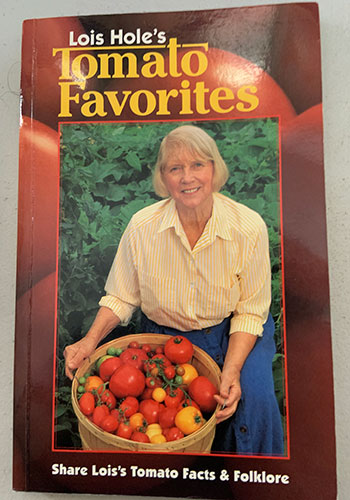 Roughly 25 years ago, when former lieutenant-governor of Alberta Lois Hole ran her garden greenhouse in St. Albert, Michetti was sous chef for Hilton International Hotels.
Roughly 25 years ago, when former lieutenant-governor of Alberta Lois Hole ran her garden greenhouse in St. Albert, Michetti was sous chef for Hilton International Hotels.
Sometimes, he’d run into her as he browsed the tomato section and they’d get to chatting. After a few visits, Hole invited him to consult on a book she was writing: Lois Hole's Tomato Favorites.
In addition to other expertise, Michetti contributed a recipe (see page 127, right under the picture of “this absolutely handsome guy,” he jokes). But he returns to the book and Hole’s tomato growing advice to this day.
“Everything you need to know about tomatoes is right here,” he says. “That's my reference. She really just writes it so simply. One of the first things she says in her introductions is tomatoes are pretty easy to grow. Great little book.”